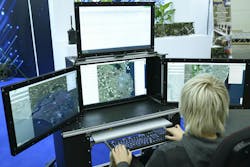NASA awards Aptima contract to help define safe human-to-UAV ratios
WOBURN, Mass. - The National Aeronautics and Space Administration (NASA) has awarded Aptima in Woburn, Mass., a contract to help develop a science-based framework for determining how many uncrewed aerial vehicles (UAVs) a single human operator can safely and effectively control.
The contract, awarded through NASA’s Langley Research Center in Hampton, Va., supports efforts to address a growing challenge in UAV operations: managing fleets of drones with fewer human operators. The work is part of NASA’s Transformational Tools and Technologies project and involves collaboration with an m:N Working Group composed of experts from government, industry, and academia.
"The m:N ratio problem is about minimizing the number of humans that can safely, reliably, and effectively oversee growing numbers of UAVs without undue cognitive overload or stress," said Dr. Samantha Emerson, a scientist in Aptima’s Performance Augmentation Systems Division and the project’s principal investigator. "The ratio itself, however, is a function of other factors and how they interact."
Safe ratios
Unlike traditional manned aviation, which typically involves a one-to-one pilot-to-aircraft ratio, UAV operations are moving toward models where a single operator may control many drones simultaneously. However, Emerson said there is currently no systematic method for defining that ratio.
Related: DLR tool detects conflict between crewed and uncrewed aircraft routes
Key factors in determining the safe ratio include the complexity of the UAV’s design and mission, the tasks required of the human operator, and how often the operator must intervene in autonomous operations.
"Even in a world of autonomous machines, the human element remains crucial," Emerson said. "Despite their autonomy, UAVs still require a human to oversee the equipment, sensors, and airspace environment."
When complete, the framework developed by Aptima and the m:N Working Group is expected to guide commercial, government, and military organizations as they develop and operate UAV systems.
"Companies need a way to show regulators that they’ve accounted for and evaluated all these factors in a systematic way and that their planned operations are at least as safe as, if not safer than, a 1:1 ratio," Emerson said. "The goal of this joint work is to lay out the factors that need to be considered when determining what that safe ratio of humans to UAVs is."
Aptima is also using an artificial intelligence tool - a large language model agent - to help analyze research and synthesize information for the project.
About the Author

Jamie Whitney
Jamie Whitney joined the staff of Military & Aerospace Electronics and Intelligent Aerospace. He brings seven years of print newspaper experience to the aerospace and defense electronics industry.
Whitney oversees editorial content for the Intelligent Aerospace Website, as well as produce news and features for Military & Aerospace Electronics, attend industry events, produce Webcasts, oversee print production of Military & Aerospace Electronics, and expand the Intelligent Aerospace and Military & Aerospace Electronics franchises with new and innovative content.
